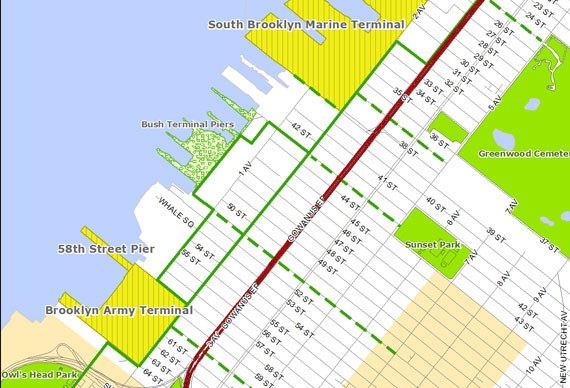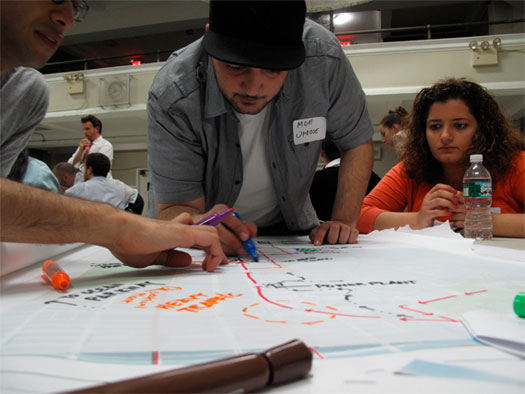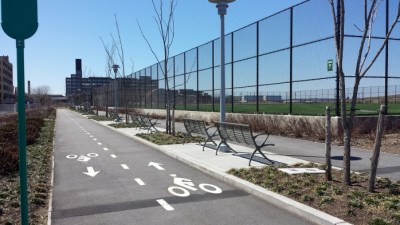Sunset Park Greenway: Big Challenges, Bigger Potential
 A map of potential greenway routes and east-west connections in Sunset Park. Image: UPROSE
A map of potential greenway routes and east-west connections in Sunset Park. Image: UPROSEA full crowd of about 60 people turned out for NYCDOT’s Brooklyn Waterfront Greenway workshop in Sunset Park last night. The meeting was the second of four sessions the city is putting on with the Brooklyn Greenway Initiative and the Regional Plan Association, as the years-in-the-making project of a continuous pedestrian and bicycle path tracing the Brooklyn waterfront moves from the concept phase to more detailed planning and engineering.
Determining a buildable greenway route in Sunset Park is a complicated proposition. The waterfront is an active industrial district filled with the sort of facilities that pose logistical hurdles for safe walking and biking. West of the BQE, the greenway route will have to negotiate obstacles like the 65th Street rail yard, the Brooklyn Army Terminal, and the active freight rail corridor on First Avenue. It won’t be easy, but as Brooklyn Greenway Initiative planning director Milton Puryear
told me last night, it’s a place where you’ve got to think big.
A finished greenway in Sunset Park would bring huge payoffs. Sunset Park has one of the highest walk-to-work rates in the city, and a major new waterfront park is slated for the Bush Terminal Piers. So in addition to providing a route along the waterfront, the greenway project is a chance to connect the residential areas east of Third Avenue to the new park and the waterfront’s industrial job center, using safe walking and bicycling paths. There’s already a well-established base of local support for creating those connections: The United Puerto Rican Organization of Sunset Park (UPROSE) started holding public workshops about the greenway and waterfront access in 2005.
The main focus of last night’s workshop was to get ideas from residents about where the greenway should go. Participants split up into groups and then presented to the whole audience.
 Mapping out a greenway route. Photo: Dan Wiley, office of Congresswoman Nydia Velazquez.
Mapping out a greenway route. Photo: Dan Wiley, office of Congresswoman Nydia Velazquez.The one theme that just about everyone repeated is that the east-west connections are just as important as the greenway itself. Walking or biking from Sunset Park to the waterfront entails crossing Fourth Avenue (basically an at-grade highway), Third Avenue (the service road for an elevated highway), and then the industrial zone of Second and First Avenues. Access to the greenway and the waterfront will depend on creating safe conditions to cross those streets.
As for the greenway route, a few groups proposed some heavy duty walk-bike infrastructure for the trickiest segments, including bridges spanning the 65th Street railyard and the Gowanus Bay, and an elevated path over First Avenue.
Soledad Gaztambide, transportation justice coordinator for UPROSE, said she was encouraged to hear people ask for routes that stay close to the water. "I’m really hoping that they put the main route along the waterfront, and First and Second," she said. "We want to have an industrial waterfront but we also think it could be multi-use."
DOT is working to build parts of the greenway footprint as soon as possible (see Kent Avenue and Flushing Avenue), but it will be a couple of years before the ideas from yesterday’s workshop show up in a final plan. The greenway master planning process, which continues with a workshop at the Red Hook Recreation Center on April 13, is slated to wrap up in 2012.


